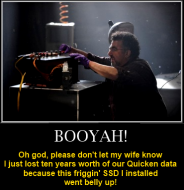First up - welcome to the forum! A
charter member since 2006 and this is only your first post? That has got to be some sort of record!

----------------
OK. On to business...
There's a couple of test articles I think you'll want to read.
First is from the folks at PC Perspective, who wax enthusiastic about it. Enough so that they made it an Editor's Choice. (Link
here.)
Final Thoughts
Ryan awarded the Z68 solution his Editor's Choice. I'm going to match his with one from the Storage Editor. I'm not only awarding for the Z68 - I'm awarding for the potential of the dynamic duo of storage goodness that it enables. The Z68 / SSD 311 combination is what hybrid hard disk drives should have been from the start, with the added bonus of being able to mate it with whichever spinning disk the user wants.
AnandTech, following another of their characteristically in-depth tests, was also generally impressed. (Full article
here.) They voiced a few reservations about the across the board performance gains for all applications, noting that the most consistent gains were in the "light use" testing scenario. (See below - emphasis added.)
Intel's Smart Response Technology (SRT) is an interesting addition to the mix. For starters, it's not going to make your high end SSD obsolete. You'll still get better overall performance by grabbing a large (80-160GB+) SSD, putting your OS + applications on it, and manually moving all of your large media files to a separate hard drive. What SRT does offer however is a stepping stone to a full blown SSD + HDD setup and a solution that doesn't require end user management. You don't get the same performance as a large dedicated SSD, but you can turn any hard drive into a much higher performing storage device. Paired with a 20GB SLC SSD cache, I could turn a 4-year-old 1TB hard drive into something that was 41% faster than a VelociRaptor.
If you're building a system for someone who isn't going to want to manage multiple drive letters, SRT may be a good alternative. Similarly, if you're building a budget box that won't allow for a large expensive SSD, the $110 adder for an Intel SSD 311 can easily double the performance of even the fastest hard drive you could put in there. The most obvious win here is the lighter user that only runs a handful of applications on a regular basis. As our tests have shown, for light workloads you can easily get the performance of an X25-M G2 out of a fast hard drive + an SSD cache.
This is understandable in that Intel has limited the absolute cache size. So with certain applications, or usage patterns, there's a good likelihood that not everything you'd want to remain cached will do so:
The Downside: Consistency
Initially it's very easy to get excited about Intel's SRT. If you only run a handful of applications, you'll likely get performance similar to that of a standalone SSD without all of the cost and size limitations. Unfortunately, at least when paired with Intel's SSD 311, it doesn't take much to kick some of that data out of the cach
..
..
..
A pure SSD setup is going to give you predictable performance across the board regardless of what you do, whereas Intel's SRT is more useful in improving performance in more limited, repetitive usage models. Admittedly most users probably fall into the latter category.
Once again it's a case of "Your mileage may vary." Like so many other things in life.

AnandTech also experienced some reliability problems while testing. Although the author of the article pointed out they were non-replicable errors and hesitated to blame SRT for them, it's enough to urge extra caution. Especially since Intel has a history of rare but serious problems emerging several months after a new technology gets introduced into their product line.
In my use I've only noticed two reliability issues with Intel's SRT. The first issue was with an early BIOS/driver combination where I rebooted my system (SSD cache was set to maximized) and my bootloader had disappeared. The other issue was a corrupt portion of my Portal 2 install, which only appeared after I disabled by SSD cache. I haven't been able to replicate either issue and I can't say for sure that they are even caused by SRT, but I felt compelled to report them nevertheless. As with any new technology, I'd approach SRT with caution—and lots of backups.
 Smart Response Technology and partitioning
Smart Response Technology and partitioningDunno...
I'm at the point where I'm going to need to do some serious building soon. But, while I like what I see with SRT, it's a little too new (and offers not quite enough) that I'm not going to jump on it right now. At the very least I'd like to let it get out in the field long enough for some real-word performance and reliability data to start coming back. Most likely I'll just wait another six months or so for
Ivy Bridge since an adequate but completely integrated GPU and native USB 3.0 support is more important to me than faster boot times and drive caching.
Yup...think I'm gonna wait and see since I don't need to do anything right this very minute.
@nosie - If you do build this beastie you're planning, please keep us informed about how you made out?
Luck!

